Order Hymenopterans Higher classification Ichneumonoidea | Scientific name Ichneumonidae | |
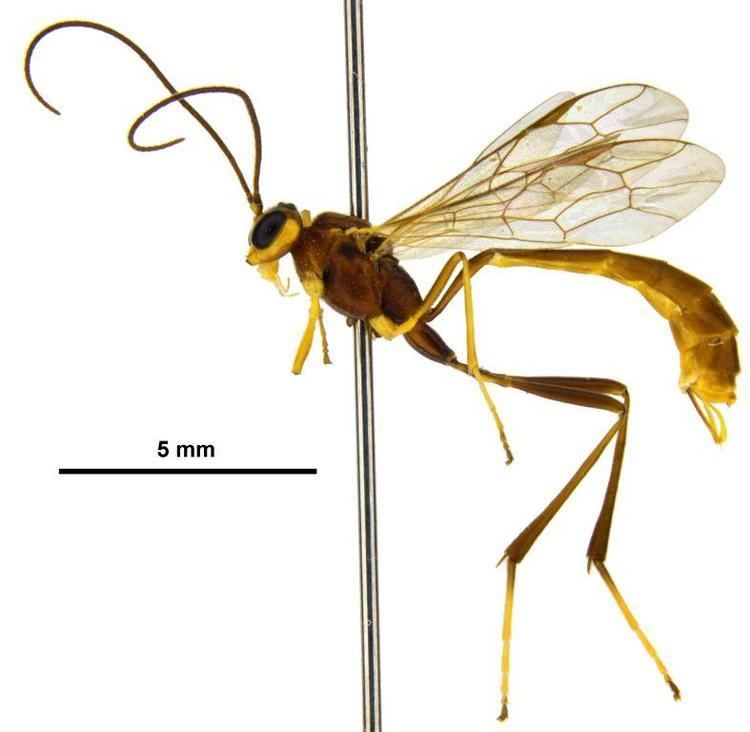 | ||
Lower classifications Pimplinae, Pimpla, Ichneumoninae, Netelia, Diadegma Similar Pimplinae , Rhyssa persuasoria , Megarhyssa | ||
Parasitic wasp attacking moth pupa ichneumonidae
The Ichneumonidae are a parasitoid wasp family within the order Hymenoptera. They are important parasitoids of other invertebrates; common hosts are larvae and pupae of Coleoptera, Hymenoptera, and Lepidoptera. Over 24,000 species have been described worldwide. Estimates of the total species range from 60,000 to over 100,000 – more than any other hymenopteran family.
Contents
- Parasitic wasp attacking moth pupa ichneumonidae
- Dolichomitus sp parasitic wasp ichneumonidae pimplinae
- Etymology and history
- Description
- Distribution
- Reproduction and diet
- Taxonomy and systematics
- Subfamilies
- Famous ichneumonologists
- Darwin and the Ichneumonidae
- References
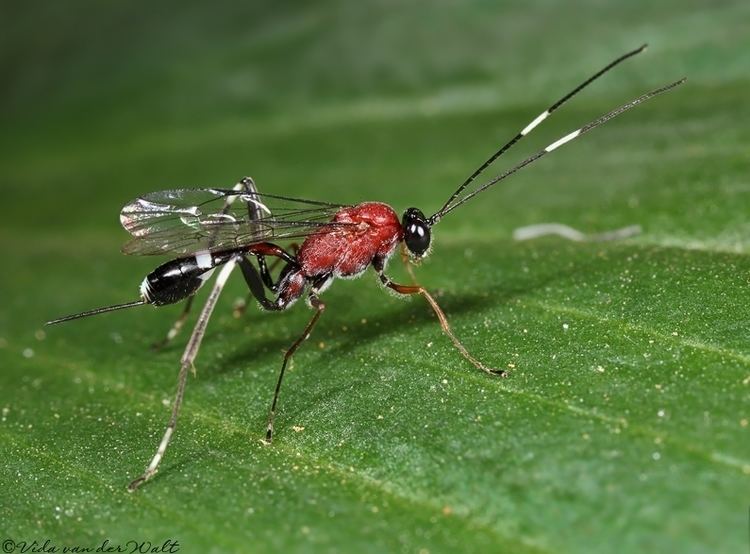
The distribution of the ichneumonids was traditionally considered an exception to the common latitudinal gradient in species diversity, since the family was thought to be at its most species rich in the temperate zone instead of the tropics, but numerous new tropical species have now been discovered.

Charles Darwin discussed the Ichneumonidae with regard to his views on religion.
Dolichomitus sp parasitic wasp ichneumonidae pimplinae
Etymology and history

Insects in the family Ichneumonidae are commonly called ichneumon wasps or ichneumonids. Less exact terms are ichneumon flies (they are not closely related to true flies), or scorpion wasps due to the extreme lengthening and curving of the abdomen (scorpions are arachnids).
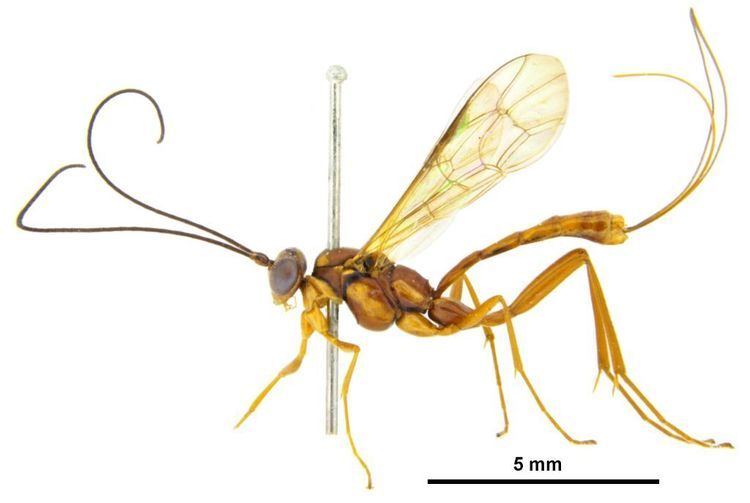
The name is derived from Latin 'ichneumon', from Ancient Greek ἰχνεύμων (ikhneúmōN, "tracker"), from ἴχνος (íkhnos, "track, footstep"). The name first appeared in Aristotle'S "History of Animals", C. 343 BC. Aristotle noted that the ichneumon preys upon spiders, is a wasp smaller than ordinary wasps, and carries its prey to a hole which they lay their larvae inside, and that they seal the hole with mud.
Description
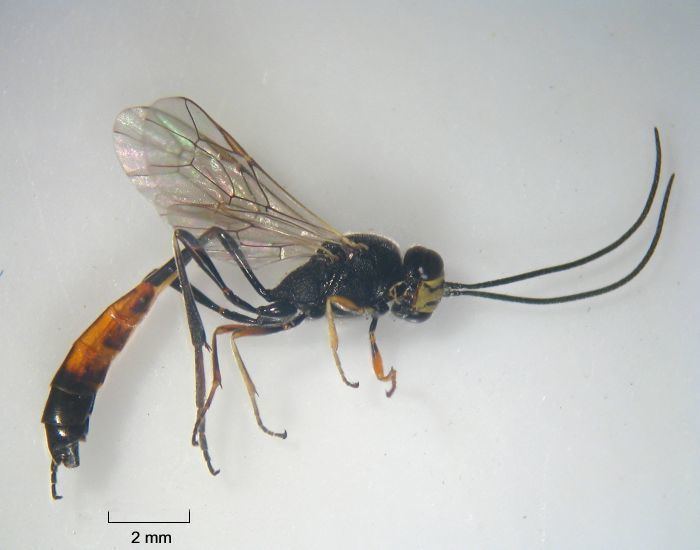
Adult ichneumonids superficially resemble other wasps. They have a slender waist, two pairs of wings, a pair of large eyes on the side of the head and three ocelli on top of the head. Their size varies considerably from a few millimetres to seven or more centimetres.
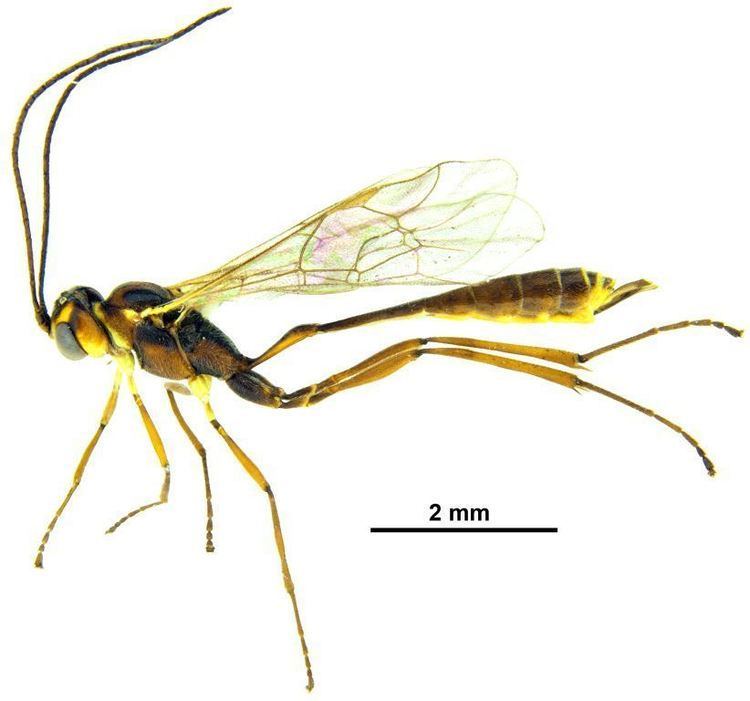
The ichneumonids differ from typical, aculeate wasps (Aculeata: Vespoidea and Apoidea), in that the antennae have more segments; typically 16 or more, while most other wasps have 13 or fewer. Unlike the aculeate wasps, which sting in defense and do not pass their eggs along the stinger, ichneumonid females have an ovipositor (homologous to the stinger) which they use to lay eggs inside or on their host. Ichneumonids generally inject venom along with the egg, but only larger species with relatively short ovipositors use the ovipositor in defense. Males do not possess stingers or ovipositors in either lineage.

Ichneumonids are distinguished from their sister group Braconidae mainly on the basis of wing venation. The fore wing of 95% of ichneumonids has vein 2m-cu, which is absent in braconids. Vein 1rs-m of the fore wing is absent in all ichneumonids, but is present in 85% of braconids. In the hind wing of ichneumonids, vein rs-m joins Rs apical to (or rarely opposite) the split between veins Rs and R1. In braconids, vein rs-m joins basal to this split. The taxa also differ in the structure of the metasoma: about 90% of ichneumonids have a flexible suture between tergites 2 and 3, whereas these tergites are fused in braconids (though the suture is secondarily flexible in Aphidiinae).
Distribution

Ichneumonids are found on all continents with the exception of Antarctica. They inhabit virtually all terrestrial habitats, wherever there are suitable invertebrate hosts.
The distribution of ichneumonid species richness is subject to ongoing debate. Long believed to be rare in the tropics, and at its most species rich in the temperate region, the family became a classic textbook example of an 'exceptional' latitudinal diversity gradient. Recently this belief has been questioned, after the discovery of numerous new tropical species.
Reproduction and diet
Some ichneumonid species lay their eggs in the ground, but most inject them either directly into their host's body or on its surface. After hatching, the ichneumonid larva eats its host alive. The most common hosts are larvae or pupae of Lepidoptera, Coleoptera and Hymenoptera, but some species also parasitise spiders. Hyperparasitoids such as Mesochorinae oviposit inside the larvae of other ichneumonids. The hosts of many species are unknown; host information has been summed up by e.g. Aubert, Perkins. and Townes.
Ichneumonids use both idiobiont and koinobiont parasitising strategies. Idiobionts paralyze their host and prevent it from growing while it is eaten. Koinobionts let their host grow and develop while they feed on it. In both strategies, the host typically dies after some weeks, after which the ichneumonid larva emerges and pupates.
Adult ichneumonids feed on a diversity of foods, including plant sap, nectar and other insects. They spend much of their active time searching, either for hosts (female ichneumonids) or for emerging females (male ichneumonids).
The predation pressure exerted by ichneumonids can be tremendous, and they are often one of the major regulators of invertebrate populations. It is quite common for 10-20% or more of a host's population to be parasitised (though reported parasitism rates often include non-ichneumonid parasitoids).
Taxonomy and systematics
The taxonomy of the ichneumonids is still poorly known. The family is highly diverse, containing 24,000 described species. Approximately 60,000 species are estimated to exist worldwide, though some estimates place this number at over 100,000. Due to the high diversity, the existence of numerous small and hard to identify species, and the majority of species being undiscovered, it has proven difficult to resolve the phylogeny of the ichneumonids. Even the relationships between subfamilies are unclear. The sheer diversity also means DNA sequence data is only available for a tiny fraction of the species, and detailed cladistic studies require major computing capacity.
Extensive catalogues of the ichneumonids include those by Aubert, Gauld, Perkins, and Townes. Due to the taxonomic difficulties involved, however, their classifications and terminology are often confusingly contradictory. Several prominent authors have gone as far as to publish major reviews that defy the International Code of Zoological Nomenclature.
Ichneumonid evolutionary history is even worse known than the modern day taxonomy. The family has existed since at least the Jurassic (ca. 150 mya), but may have appeared some time before. It diversified during the Oligocene.
Subfamilies
In 1999, the ichneumonids were divided into 39 subfamilies, whose names and definitions have varied considerably. The phylogenetic relationships between the subfamilies are still unclear.
Famous ichneumonologists
Famous ichneumonologists include:
Darwin and the Ichneumonidae
The apparent cruelty of the ichneumonids troubled philosophers, naturalists, and theologians in the 19th century, who found the parasitoid life style inconsistent with the notion of a world created by a loving and benevolent God. Charles Darwin found the example of the Ichneumonidae so troubling that it contributed to his increasing doubts about the nature and existence of a Creator. In an 1860 letter to the American naturalist Asa Gray, Darwin wrote:
I own that I cannot see as plainly as others do, and as I should wish to do, evidence of design and beneficence on all sides of us. There seems to me too much misery in the world. I cannot persuade myself that a beneficent and omnipotent God would have designedly created the Ichneumonidae with the express intention of their feeding within the living bodies of Caterpillars, or that a cat should play with mice.
